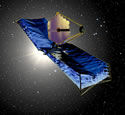
Image credit: NASA
NASA announced today that it has awarded an $825 million contract to aerospace firm TRW to build the replacement for the Hubble Space Telescope: The James Webb Space Telescope. Named for NASA’s second administrator, this new observatory will launch in 2010 and operate 1.5 million km away from the Earth (Hubble is in low-Earth orbit). If all goes as planned, the observatory’s 6 metre mirror will offer a tremendous leap in resolution over Hubble.
NASA today selected TRW, Redondo Beach, Calif., to build a next-generation successor to the Hubble Space Telescope in honor of the man who led NASA in the early days of the fledgling aerospace agency.
The space-based observatory will be known as the James Webb Space Telescope, named after James E. Webb, NASA’s second administrator. While Webb is best known for leading Apollo and a series of lunar exploration programs that landed the first humans on the Moon, he also initiated a vigorous space science program, responsible for more than 75 launches during his tenure, including America’s first interplanetary explorers.
“It is fitting that Hubble’s successor be named in honor of James Webb. Thanks to his efforts, we got our first glimpses at the dramatic landscapes of outer space,” said NASA Administrator Sean O’Keefe. “He took our nation on its first voyages of exploration, turning our imagination into reality. Indeed, he laid the foundations at NASA for one of the most successful periods of astronomical discovery. As a result, we’re rewriting the textbooks today with the help of the Hubble Space Telescope, the Chandra X-ray Observatory and, in 2010, the James Webb Telescope.”
The James Webb Space Telescope is scheduled for launch in 2010 aboard an expendable launch vehicle. It will take about three months for the spacecraft to reach its destination, an orbit 940,000 miles or 1.5 million kilometers in space, called the second Lagrange Point or L2, where the spacecraft is balanced between the gravity of the Sun and the Earth.
Unlike Hubble, space shuttle astronauts will not service the James Webb Space Telescope because it will be too far away.
The most important advantage of this L2 orbit is that a single-sided sun shield on only one side of the observatory can protect Webb from the light and heat of both the Sun and Earth. As a result, the observatory can be cooled to very low temperatures without the use of complicated refrigeration equipment. These low temperatures are required to prevent the Webb’s own heat radiation from exceeding the brightness of the distant cool astronomical objects.
Before and during launch, the mirror will be folded up. Once the telescope is placed in its orbit, ground controllers will send a message telling the telescope to unfold its high-tech mirror petals.
To see into the depths of space, the James Webb Space Telescope is currently planned to carry instruments that are sensitive to the infrared wavelengths of the electromagnetic spectrum. The new telescope will carry a near-infrared camera, a multi-object spectrometer and a mid-infrared
camera/spectrometer.
The James Webb Space Telescope will be able to look deeper into the universe than Hubble because of the increased light- collecting power of its larger mirror and the extraordinary sensitivity of its instruments to infrared light. Webb’s primary mirror will be at least 20 feet in diameter, providing much more light gathering capability than Hubble’s eight-foot primary mirror.
The telescope’s infrared capabilities are required to help astronomers understand how galaxies first emerged out of the darkness that followed the rapid expansion and cooling of the universe just a few hundred million years after the big bang. The light from the youngest galaxies is seen in the infrared due to the universe’s expansion.
Looking closer to home, the James Webb Space Telescope will probe the formation of planets in disks around young stars, and study supermassive black holes in other galaxies.
Under the terms of the contract valued at $824.8 million, TRW will design and fabricate the observatory’s primary mirror and spacecraft. TRW also will be responsible for integrating the science instrument module into the spacecraft as well as performing the pre-flight testing and on-orbit checkout of the observatory.
The Goddard Space Flight Center, Greenbelt, Md., manages the James Webb Space Telescope for the Office of Space Science at NASA Headquarters in Washington. The program has a number of industry, academic and government partners, as well as the European Space Agency and the Canadian Space Agency.
Original Source: NASA News Release

Since the ancestral time, world space research is progressing on wrong concept because we unknown about space mirror which is a great mystery and creator of lots of mysteries viz. milk ways, galaxies, nebulas, white drafts, black holes etcs. Hence without study of space mirror the space research has no future.
Therefore it invites to visit http://www.spacemirrormystery.com to know the original truth and for prosperous space research.
Mirror reflects frontier. Mirror functions like a wall. There is nothing ahead of mirror but reflection makes lively atmosphere into mirror. If two mirrors face each other in parallel position the concerned area between mirrors is converted to a biggest atmosphere because the concerned area reflected unlimitedly as front side and backside into each mirror frequently. Space mirror is based on above rule and we are unknown about space mirror. Since from sun the objects of area 225 million kilometer to 300 million kilometer of solar system reflects unlimitedly, we find a very deep space and through giant telescopes we watch mystery after mystery. Telescope enlarges view not closes near view. Following may clear the concept “A visitor of a desert often find mirage. If he moves mirage also moves. He can never reach near the mirage. If he tries he can see enlarge view of mirage as smoky atmosphere through a telescopic instrumentâ€.
Giant telescope like Hubble may be the milestone of our technology but it can not help the real space research.